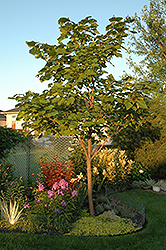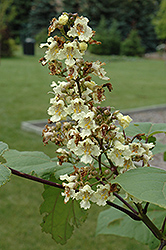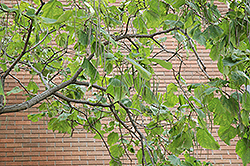Height: 40 feet
Spread: 25 feet
Sunlight:
![]()
![]()
Hardiness Zone: 3b
Description:
A small ornamental tree with very large, coarse leaves, showy orchid-like flowers in early summer, and interesting long, narrow beanpod-shaped fruit in fall; use where a coarse texture is required, makes a spectacular specimen for the front yard
Ornamental Features
Chinese Catalpa features subtle panicles of lightly-scented buttery yellow orchid-like flowers with yellow throats rising above the foliage in mid summer. It has green deciduous foliage. The large lobed leaves do not develop any appreciable fall colour. The fruits are showy brown pods displayed from mid summer to late winter. The fruit can be messy if allowed to drop on the lawn or walkways, and may require occasional clean-up.
Landscape Attributes
Chinese Catalpa is a deciduous tree with a more or less rounded form. Its strikingly bold and coarse texture can be very effective in a balanced landscape composition.
This tree will require occasional maintenance and upkeep, and is best pruned in late winter once the threat of extreme cold has passed. It is a good choice for attracting hummingbirds to your yard, but is not particularly attractive to deer who tend to leave it alone in favor of tastier treats. Gardeners should be aware of the following characteristic(s) that may warrant special consideration;
- Messy
Chinese Catalpa is recommended for the following landscape applications;
- Accent
- Shade
Planting & Growing
Chinese Catalpa will grow to be about 40 feet tall at maturity, with a spread of 25 feet. It has a low canopy with a typical clearance of 5 feet from the ground, and should not be planted underneath power lines. It grows at a fast rate, and under ideal conditions can be expected to live for 70 years or more.
This tree does best in full sun to partial shade. It is an amazingly adaptable plant, tolerating both dry conditions and even some standing water. It is considered to be drought-tolerant, and thus makes an ideal choice for xeriscaping or the moisture-conserving landscape. It is not particular as to soil type or pH, and is able to handle environmental salt. It is somewhat tolerant of urban pollution. This species is not originally from North America.



